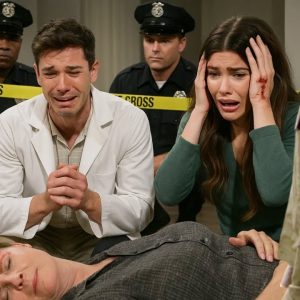Los Angeles, CA — In a dramatic turn of events that has shaken the very foundations of “The Bold and the Beautiful,”
Thomas Forrester has returned from Paris, reformed in appearance but armed with an agenda that blends art, obsession,
and raw emotion. At the center of this emotional storm? Hope Logan—and the man standing between them, Carter Walton.
After months abroad, Thomas emerged from his self-imposed exile in Paris a changed man—at least on the surface. Speaking in solemn tones of spiritual growth and enlightenment, he described his time in France as a confrontation with his inner darkness. Cloaked in talk of clarity and creative rebirth, Thomas’s return has been marked not by remorse, but by a calculated plan to reclaim what he believes is rightfully his.
And his primary target? Hope Logan.
But Thomas isn’t just seeking reconciliation or artistic collaboration. His return comes with Remission—a dark, provocative couture line that merges fashion with the emotional complexities of seduction, redemption, and unresolved desire. Inspired by the ghosts of his past and fueled by an aching need to rewrite history, Remission is both a collection and a confession.
The Collection as a Weapon
Unveiled at Logan Designs, Remission is nothing short of psychological warfare wrapped in black silk and velvet. Minimalist in silhouette but maximalist in emotion, the line is a visual metaphor for Thomas’s inner turmoil—fitted jackets with sharp edges symbolizing protection, column gowns that both conceal and reveal, and blood-red accents emerging from monochrome shadows.
And at the heart of it all is Hope.
Hope agrees to collaborate professionally, unaware of the emotional web Thomas is slowly spinning. Ever the consummate professional, she steps into the role of muse with grace, attending test fittings and providing artistic feedback. But Thomas’s intentions run deeper. With every private meeting, every creative brainstorming session, he gently chips away at her emotional boundaries, drawing her in under the guise of inspiration.
Carter Sees the Cracks
At first, Carter Walton—Hope’s partner in both love and business—supports the collaboration. He trusts Hope’s independence, and to some extent, he even dares to believe in Thomas’s transformation. But as creative sessions grow increasingly intimate, and Hope’s unease becomes more visible, Carter’s instincts flare.
He suggests limits: no late-night fittings, no closed-door meetings. Thomas agrees with a smile, then promptly finds ways around them—”urgent” sketches, “accidental” run-ins, and quiet coffees just for “feedback.” Hope remains focused on the collection’s success, brushing off Carter’s concern as overprotectiveness.
But Carter isn’t imagining things.
A Fitting Turns Into a Confession
The turning point arrives during a test fitting. Hope steps into a showstopper gown: a black corseted piece lined with red silk, the very embodiment of temptation and duality. As she stands before the mirror, Thomas steps behind her and whispers, “This is what redemption feels like.”
The tone is intimate, too personal. The line between art and affection blurs. And just as the moment threatens to boil over, Carter enters—shattering the tension, but not the intent. Thomas, ever the tactician, steps back with a gracious smile. The damage, however, is done.
The Launch: A Show of Power
The runway launch of Remission is a spectacle. Forester’s legendary runway is draped in black velvet. Models move like ghosts through the dark, while Hope emerges in the finale, crowned in red roses, surrounded by floating petals. The crowd erupts. Hope glows with strength, but Carter, watching from the sidelines, sees something more than pride in Thomas’s eyes. He sees conquest.
In interviews following the show, Hope speaks poetically about healing and creativity, but her soft glances toward Thomas do not go unnoticed. Carter’s fears deepen as speculation swirls online. Gossip blogs reignite the Thomas-Hope romance rumors. Taglines read like prophecy: From Shadows to Light.
Tensions Boil Over
A celebratory dinner becomes a minefield of subtext. Candles flicker, champagne flows, and Thomas’s charm takes center stage. He speaks of Paris, cathedrals, second chances. When Hope briefly touches his hand, Carter’s restraint is tested to the limit.
Behind the scenes, Carter tries to reclaim control. He meets with Liam Spencer, Hope’s old flame and friend, hoping to reinforce Hope’s support system. Together, they observe Thomas’s calculated manipulation. They know: this is more than fashion. This is obsession dressed as artistry.
The Breaking Point
During a portrait film shoot, Thomas leans in close to Hope once too often. She tenses. Carter walks in. The confrontation is quiet but firm: “Maybe you should give her space.” Thomas smiles but backs off. Later, Hope confronts him: “What do you want from me?” His answer—”Truth”—offers no clarity, only confusion.
The emotional toll weighs heavy. When a tearful Hope texts Carter—What have I done?—he rushes home to find her exhausted, emotionally drained, and unsure of her footing. He embraces her and promises: We step back.
The Fallout—and the Next Move
Carter informs Thomas that Hope will no longer participate. Thomas reacts with diplomatic acceptance but sees it as merely the next act in his play. He vanishes to Paris once again and announces a global expansion of Remission—with Hope as the campaign’s international face. The catch? Refuse, and she vanishes from the collection’s legacy.
Hope is torn. Loyalty, identity, career—all swirl in conflict. At a Paris gala, she appears, dazzling in red. Her public statements are carefully measured. She names Carter her “partner in everything,” but the image of Thomas, standing backlit in the wings, lingers in the media coverage.
Resolution or Rebirth?
Back in L.A., Hope returns home, jet-lagged and haunted. She crumbles in Carter’s arms: “He used me.” And Carter, steady and strong, replies, “You’re stronger than his games.”
In executive boardrooms, the aftermath simmers. Logan Designs praises Hope’s poise under pressure. Carter reevaluates his role in business and love. The industry buzzes with questions: Can artistic genius exist without emotional manipulation? Can love survive the stage lights?
And Thomas?
He stands alone in his Paris atelier, surrounded by success but devoid of connection. A glass of wine in hand, he stares at a framed photo of himself and Hope on the runway. His expression? Bittersweet.
He won the collection. He lost the woman.
In the end, Remission wasn’t just a fashion line—it was a battlefield. A reckoning. A test of emotional fortitude, artistic boundaries, and the resilience of love.
And though the curtains have closed on this chapter, the emotional scars remain. The Bold and the Beautiful reminds us: some stories don’t end. They evolve.





